

“A woman behaves differently from a man; we give life and take care of it. Men cut down trees and we plant seeds.”
Danixa Milena Moreno Miraña, Indigenous Nonuya woman.
“We must recognize our Indigenous women for the courage with which they faced mining. They were braver than men.”
Elio Miraña.
In the last decade, the serenity of the rivers of the Colombian Amazon has been interrupted by hundreds of rafts that navigate its waters searching for gold and leaving a trace of sediment behind. Journeys can last days or weeks as miners vacuum the riverbeds with hoses. Tons of stones, sand, and organic material are sucked to obtain a few grams of gold.
The mining operation, clearly illegal as it is carried out in areas with some type of environmental protection, causes considerable damage to river ecosystems. The removal of sediment from the riverbeds destroys the food source for fish and other animals, and its subsequent dumping into the same looted rivers reduces the oxygen necessary for the survival of flora and fauna. Worse than that, these rivers are being poisoned by the mercury used to extract the gold. In short, and as expressed by several Indigenous people, "mining turns our rivers into deserts (...) there may be water, but it is lifeless and poisoned."
It is not by chance that in the last decade illegal mining has taken over the Colombian Amazon rivers. Since 2005, the international price of gold has practically quadrupled, making it a business equal to or even more attractive than drug trafficking. This gold rush has attracted both foreigners and people from other parts of the country and has broken the social fabric of the Indigenous communities that live in their basins. The desire for enrichment and easy money has led Indigenous people to meddle in mining and turn their backs on their ancestral culture and traditions.
With illegal mining come illegal armed groups that profit from environmental damage and the violation of human rights committed against Indigenous communities. In addition to financing the operation, these groups set up a gold trafficking network that includes the supply chains of materials for exploitation and marketing that ends with its legalization in the country's large cities.
This is the story of an activity that brings millions of profits to a few and fuels the Colombian armed conflict but threatens to wipe out the Amazon and the Indigenous communities that live there. They refuse to live an uncertain future and have taken actions to safeguard the jungle and with it, their ancestral culture.
Colombia is experiencing a gold boom due to the high international prices of this precious metal and the increase in its production in the country. Between 2005 and 2021, an ounce went from around 500 to 1,800 dollars and during 2022, it has had peaks of more than 2,000 dollars. Meanwhile, according to data from the Colombian Mining Information System, the country has had two gold production booms: one between 2011 and 2016 when it went from producing 1.7 million troy ounces to 2 million troy ounces, and another, which began last year with the 2.5 million troy ounces extracted from Colombian soil and rivers.
The good news contrasts with the bad ones given by the reports of the National Comptroller's Office and the United Nations Office on Drugs and Crime (UNODC). The first states that "nearly 85 percent of the gold that Colombia is exporting is the product of illegal mining," while the second says that 65 percent of gold exploitation is illegal. In other words, a good part of the mining activity is being conducted without the necessary environmental permits or in areas where gold exploitation is prohibited.
This problem affects the main producing departments such as Antioquia and Chocó, but due to the gold boom, the absence of the State, and the presence of illegal armed groups, mining has expanded throughout the Amazon River basin, especially in the Atabapo, Inírida, Apaporis, Yarí, Caquetá, Putumayo, Puré and Cotuhé rivers. There, armed groups dominate gold production and ally with Brazilian and Peruvian mafias as part of a transnational illegal business chain. Borders and their urban centers become gates through which contraband supplies and gold enter and leave.
The business is a millionaire and profitable one because, as the delegate comptroller for the environment, Gabriel Adolfo Jurado, said, "compared to the illicit cocaine business, where a kilo of coca can be in the Colombian market for around 5 million pesos, a kilo of illegal gold is in the order of 250 million pesos”. But the boom benefits a few and the inhabitants of the Amazon are the ones who bear the environmental and social losses.
The mining rafts are difficult to hide and, in an overflight made over any Amazon River, they are always easy to identify.
Photo: Nicolás Acevedo Ortíz.
Miners on a raft can last up to a month traversing the Amazon rivers.
Photo: Nicolás Acevedo Ortíz.
Unfortunately, the triple border between Brazil, Colombia, and Peru became the epicenter of illegal gold trafficking.
Photo: Santiago Ramírez.
With the rise of illegal mining, the inhabitants of cities like Leticia feel that they are being stigmatized for the simple fact of living in a place where mafias do their business.
Photo: Santiago Ramírez.
Although rafts now have a bad reputation for being used for illegal gold mining, they are a fundamental element of Amazonian society. Businesses of all kinds are built on them: workshops, shops, and even nightclubs.
Photo: Santiago Ramírez.
Authorities have set off alarms due to the high concentrations of mercury in some species of Amazonian fish that are traded both in the basin and in the rest of the country.
Photo: Santiago Ramírez.
In addition to the contamination of its basin, the erosion of its banks and sedimentation has increased significantly in recent years.
Photo: Santiago Ramírez.
Although deforestation in the department of Amazonas is almost non-existent, the region's Indigenous people do believe that the loss of forest in the Amazon foothills is affecting them. They feel that their water channels are drying up.
Photo: Santiago Ramírez.
For the Indigenous cultures of the Amazon, rivers and water channels not only give them life and sustenance but are also part of their worldview and spiritual life.
Photo: Santiago Ramírez.
For its inhabitants, all life revolves around the Amazon River. Many even go there to rest and relax. They play on the shore, fish, or simply lie down on its fine sand beaches.
Photo: Santiago Ramírez.
Mining raft on the Caquetá River, Amazonas.
A mining raft can extract around 40 grams of gold a day, more or less a kilo of gold a month.
The price of a kilo of mercury varies from the place where it is purchased and depends on supply and demand, but it can cost between 500,000 and 1,000,000 pesos.
It is estimated that to obtain a kilo of gold, 2 kilos of mercury are needed, but many miners say that they can spend up to 5 kilos.
In addition to contamination by sedimentation, the rafts spill oil and other chemical residues that are ejected by motors and motorized pumps into the rivers.
The illegal extraction of gold in the Amazon rivers not only causes irreparable environmental damage, but it also affects critically the health and social fabric of the communities that inhabit the areas where this activity is conducted. The main victims are Indigenous communities.
The map, made by the Foundation for Conservation and Sustainable Development (FCDS for its initials in Spanish) as a result of a compilation of 12 studies carried out by different NGOs, universities, and State institutions, shows the Amazon rivers where gold mining has been conducted and where high levels of mercury have been recorded in both people and animals.
According to the World Health Organization (WHO), the maximum that a person can have in their body is 1.0 µg/g (ppm). In some regions, hair samples give measurements between 15.4 and 19.7 µg/g (ppm).
Elevated levels of mercury are also found in fish, the food of communities in the Amazon River basins of large cities in the country.
Illegal mining dynamics have a critical impact on water resources. The most affected rivers by mining and contamination are Putumayo, Caquetá, Puré, Cotuhé, Apaporis, and Inírida.
Despite the fact that the use of mercury in mining is prohibited in Colombia, Amazon rivers are still contaminated with this metal. Where do illegal miners get mercury?
Mercury mainly comes from Mexico, China, and Russia.
It passes into Peru through the border located in the region of Puno and Madre de Dios.
It arrives in Brazil through the triple border Peru-Bolivia-Brazil located in the south of the State of Acre.
From there, it goes to the Ecuadorian Amazon and northern Peru.
It enters Colombia through its part of the Amazon, either through Ecuador, Peru, or Brazil.
Mercury comes from China.
From there, it goes to Venezuela and Brazil.
It enters Colombia through the Orinoco or the border with Brazil in Vaupés, Guainía, and Amazonas.
Illegal alluvial mining in the Caquetá River began in the late 1990s with the arrival of Brazilian and Peruvian miners who traveled on their rafts vacuuming the riverbed. According to the Ombudsman's Office, both indigenous and peasant communities allowed foreign presence in exchange for payments, but soon after, because of the damage it caused to their environment and their social fabric, they prohibited it. Thus, the advance of this scourge through the region was stopped.
The situation changed after 2010, when Colombian miners, sheltered by the FARC, adopted Brazilian and Peruvian technology, and began a new mining cycle. On this occasion, indigenous communities participated actively because of poverty and guerrilla coercion. The contamination of the river and its tributaries due to increased sedimentation and mercury caused severe damage to the environment and the health of the region's inhabitants. In addition, the money from gold mining affected the social fabric of indigenous communities.
A case that accounts for the drama of illegal mining is that of the Bora and Miraña communities that inhabit the Cahuinar National Natural Park. An investigation from 2015 done by universities and state and departmental entities showed that in 200 indigenous people of both towns the concentration of mercury was between 15.4 and 19.7 µg/g (ppm), values extremely higher than what was stipulated by the World Health Organization (WHO), which is just 1.0 µg/g (ppm).
With the departure of the FARC from the region, the dissidents of that guerrilla seized the business and entered into a war among themselves to increase territorial control and ensure the income of the million-dollar business. Added to this situation is the alliance of these groups with Brazilian criminal mafias. In the middle, there are the indigenous people who have suffered from forced recruitment and the violation of other human rights. They have also seen how young people abandon their ancestral traditions to seek wealth as rafters.
Caquetá river, limits between Caquetá and Amazonas.
Mercury not only contaminates water, but also air. It happens when miners heat the amalgam of mercury and gold. The former turns into vapor and is breathed in by humans and animals.
Indigenous cultures in voluntary isolation are at risk due to the advance of illegal mining in their territories.
To fight against illegal mining, the military launched the Perseus Plan.
There are several methods used by illegal miners to extract gold such as dredges and backhoes, but the most popular one is the rafts that navigate the rivers of the Colombian Amazon.

On two floats (which can be two canoes, two rows of barrels, or two kinds of barges made of wood) boards are placed perpendicular to each other to form a plank.
A triangular roof is built on the plank to cover the machinery and the hammocks. In the most sophisticated rafts, a second floor is built to house the illegal miners.
At one end there is an engine that feeds the hose that extracts the rocky material from the river and a motor pump that provides air to the miner who is submerged.
Between the machinery and the other end, a sloping gutter is built in which the lowest part lies over the river.
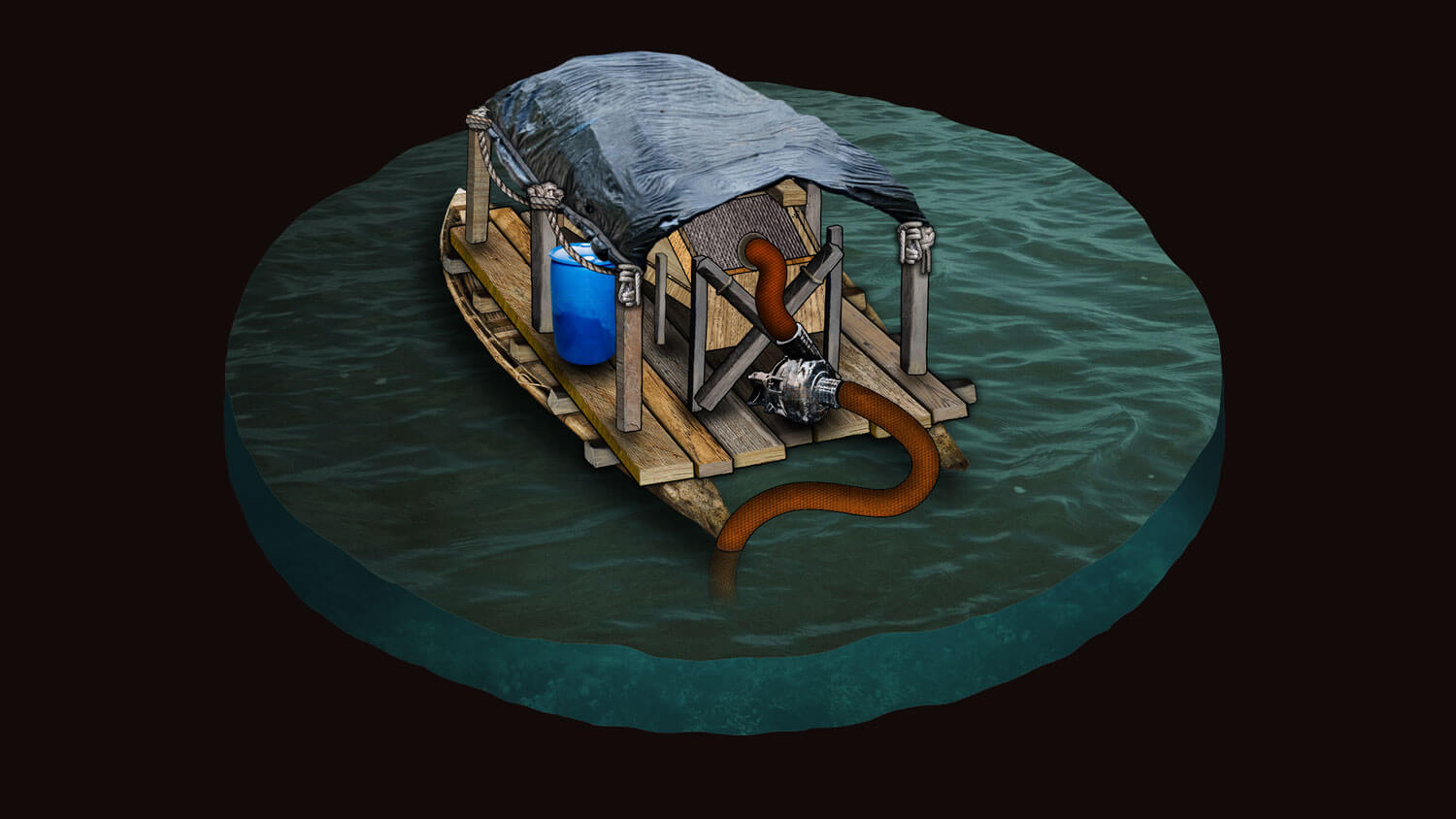
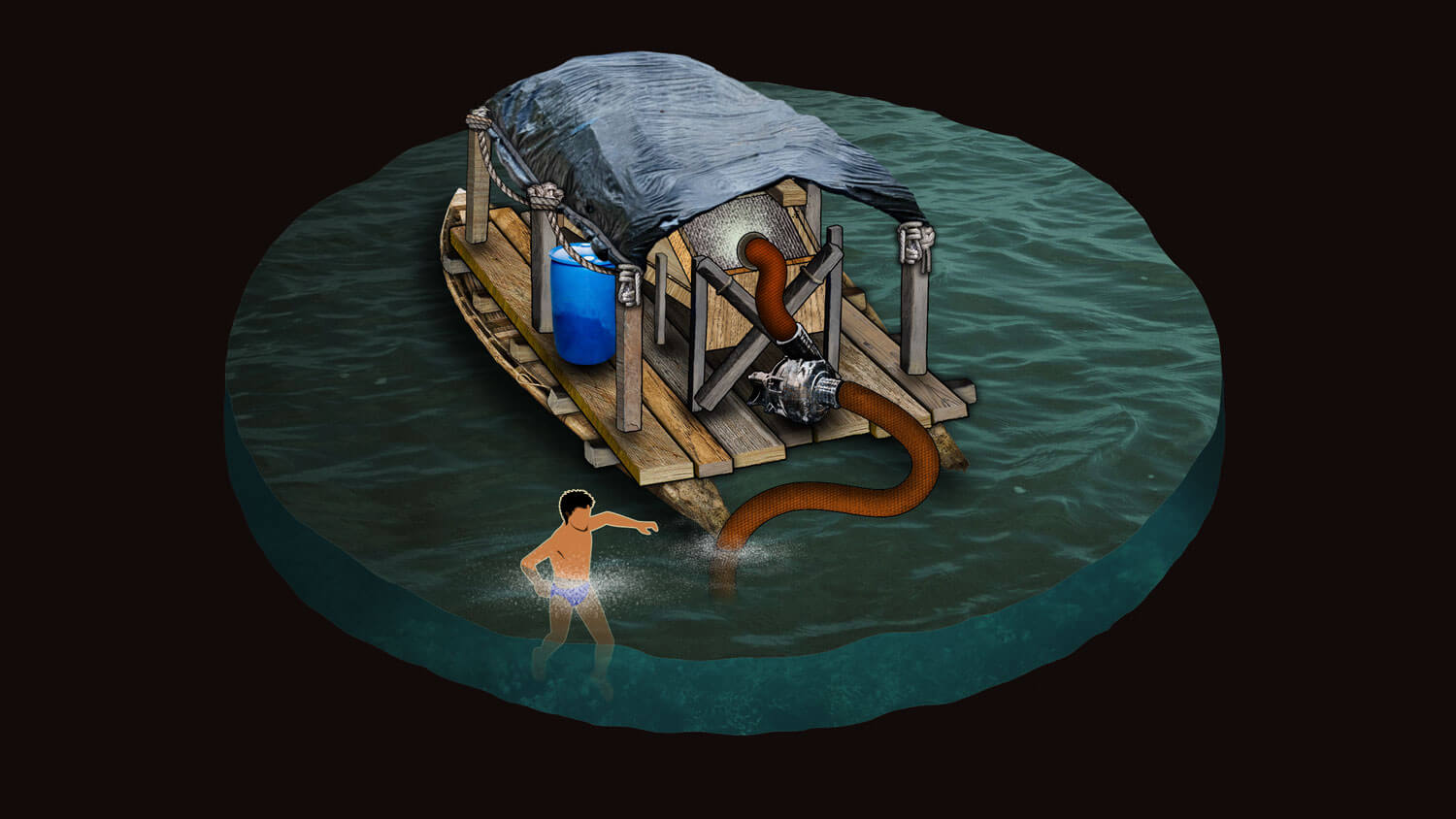
Mining begins when the diver submerges with the suction hose to locate it on the riverbed. In order to last longer underwater, the diver puts a hose connected to a motor pump that provides air in his/her mouth.
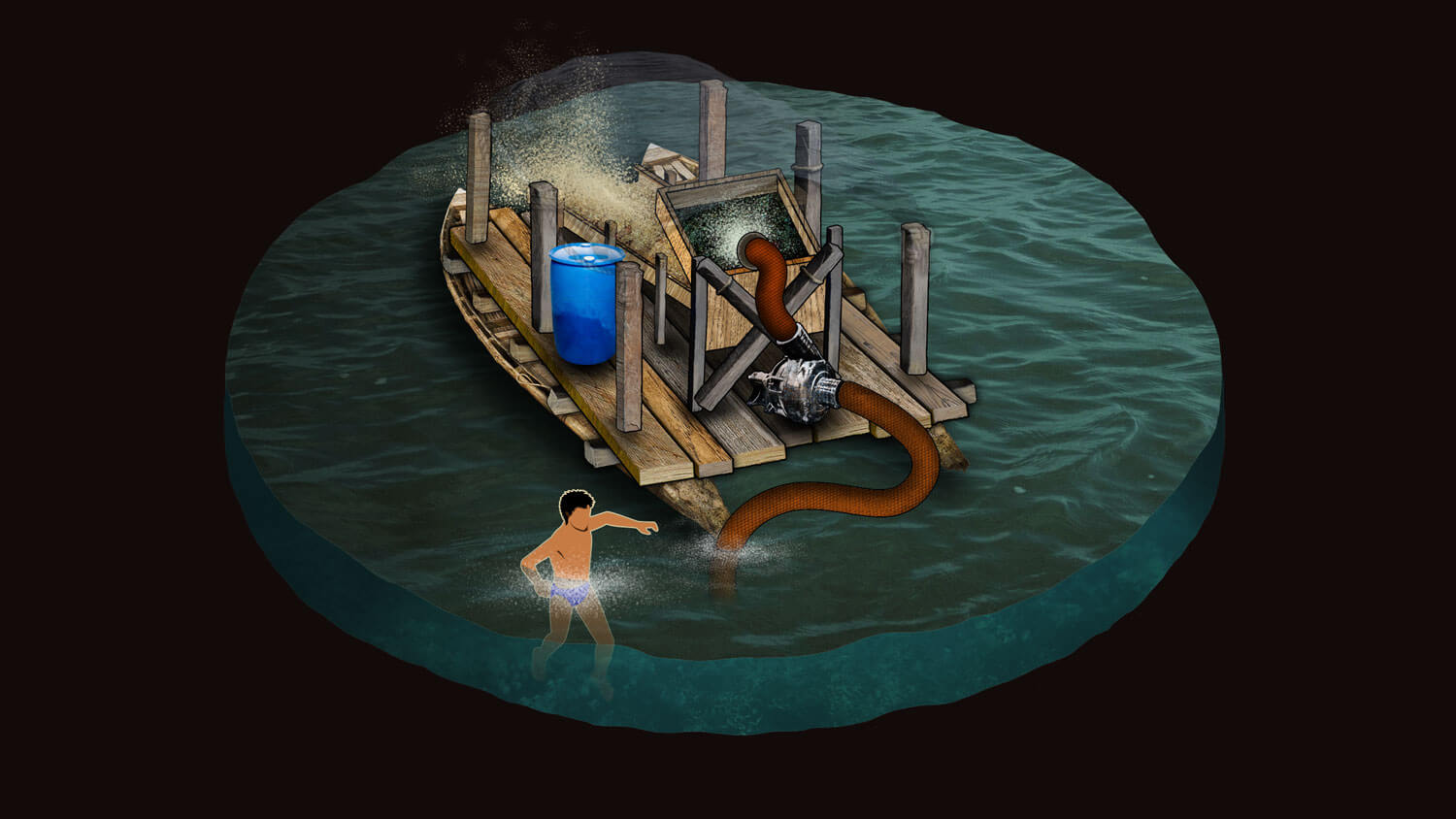
The sucked rock material and water flow over the gutter which has a filter at its upper end that retains tiny gold particles along with small rocks, mud, and sand.
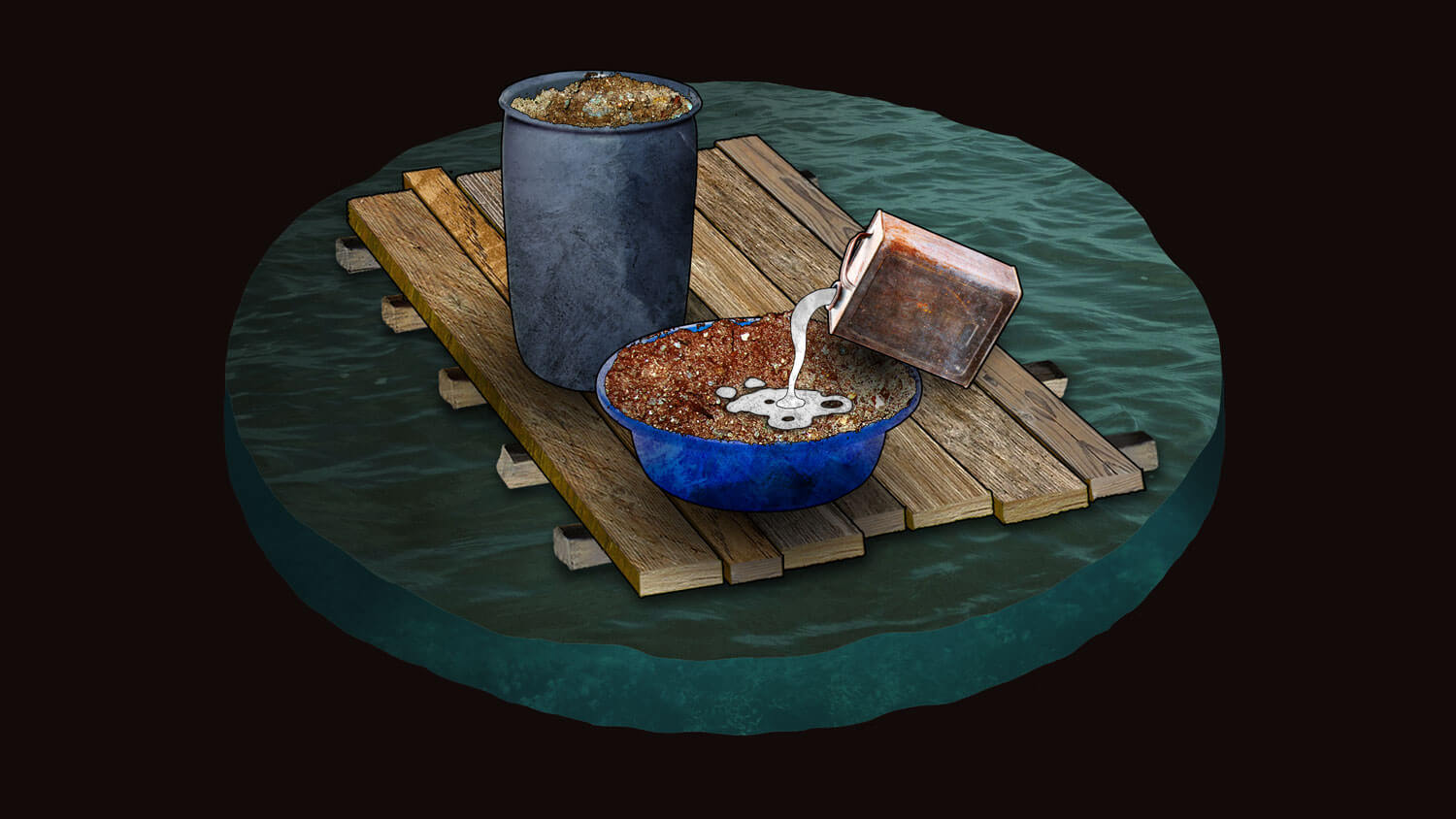
The cloth with the collected sediments is passed to a bucket with water where mercury is added so that it amalgamates with the gold particles.
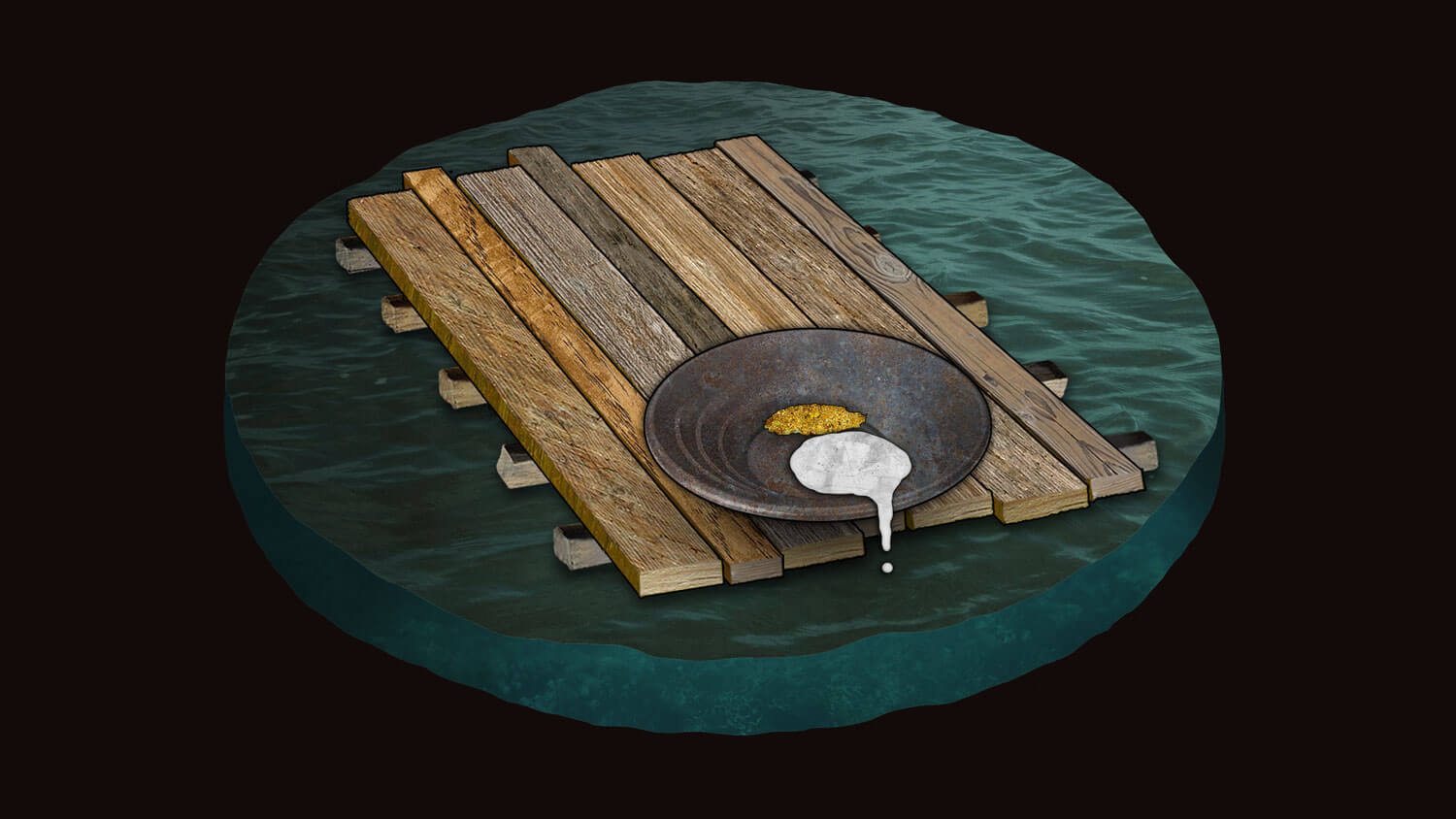
The amalgam of gold and mercury is deposited in a concave metal container (which can be anything from a spoon to a pan) and is placed on direct heat from a stove so that the mercury evaporates and only gold remains. This operation can be done on the raft or dry land.
Wastewater containing elevated levels of mercury is dumped into the river.
After this process, the gold enters a commercial chain that includes local merchants and armed groups, until it reaches cities like Bogotá. There, through fraudulent strategies, such as the falsification of import records, gold is legalized.
Caquetá river, limits between Caquetá and Amazonas.
The increase in illegal mining, deforestation, and land grabbing, added to the problems caused by confrontation between the different illegal groups that are fighting to control the area, could result in a bleak future for the Colombian Amazon. However, its inhabitants do not resign themselves and keep living in a region without its greenery and abundant water. They have conducted actual plans to change the tragic fate that some want to bring to the Amazon.

























































